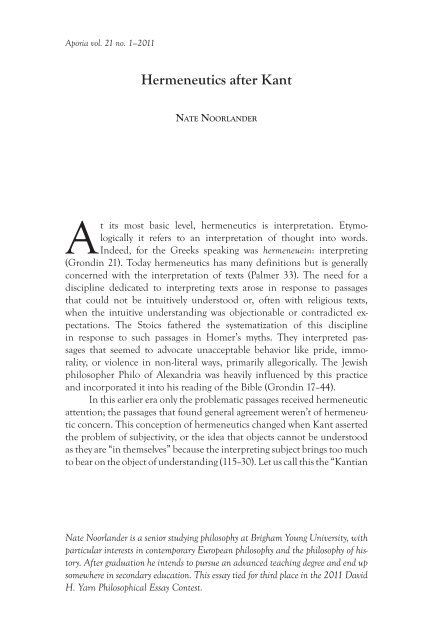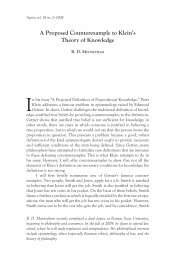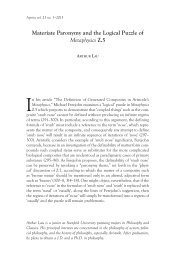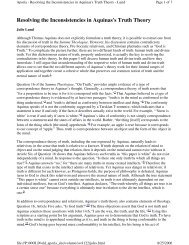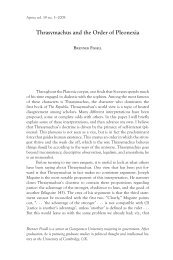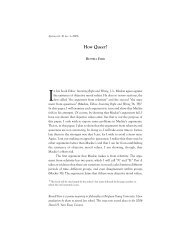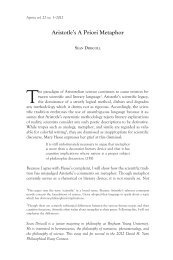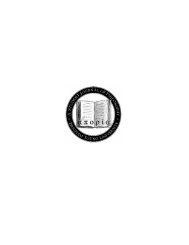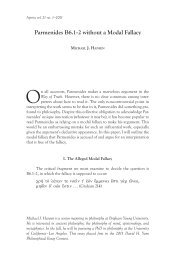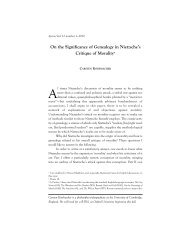Hermeneutics after Kant - Aporia - Brigham Young University
Hermeneutics after Kant - Aporia - Brigham Young University
Hermeneutics after Kant - Aporia - Brigham Young University
Create successful ePaper yourself
Turn your PDF publications into a flip-book with our unique Google optimized e-Paper software.
<strong>Aporia</strong> vol. 21 no. 1—2011<br />
<strong>Hermeneutics</strong> <strong>after</strong> <strong>Kant</strong><br />
Nate NoorlaNder<br />
At its most basic level, hermeneutics is interpretation. Etymologically<br />
it refers to an interpretation of thought into words.<br />
Indeed, for the Greeks speaking was hermeneuein: interpreting<br />
(Grondin 21). Today hermeneutics has many definitions but is generally<br />
concerned with the interpretation of texts (Palmer 33). The need for a<br />
discipline dedicated to interpreting texts arose in response to passages<br />
that could not be intuitively understood or, often with religious texts,<br />
when the intuitive understanding was objectionable or contradicted expectations.<br />
The Stoics fathered the systematization of this discipline<br />
in response to such passages in Homer’s myths. They interpreted passages<br />
that seemed to advocate unacceptable behavior like pride, immorality,<br />
or violence in non-literal ways, primarily allegorically. The Jewish<br />
philosopher Philo of Alexandria was heavily influenced by this practice<br />
and incorporated it into his reading of the Bible (Grondin 17–44).<br />
In this earlier era only the problematic passages received hermeneutic<br />
attention; the passages that found general agreement weren’t of hermeneutic<br />
concern. This conception of hermeneutics changed when <strong>Kant</strong> asserted<br />
the problem of subjectivity, or the idea that objects cannot be understood<br />
as they are “in themselves” because the interpreting subject brings too much<br />
to bear on the object of understanding (115–30). Let us call this the “<strong>Kant</strong>ian<br />
Nate Noorlander is a senior studying philosophy at <strong>Brigham</strong> <strong>Young</strong> <strong>University</strong>, with<br />
particular interests in contemporary European philosophy and the philosophy of history.<br />
After graduation he intends to pursue an advanced teaching degree and end up<br />
somewhere in secondary education. This essay tied for third place in the 2011 David<br />
H. Yarn Philosophical Essay Contest.
74<br />
Nate NoorlaNder<br />
problem.” In this paper I deal with the way this problem was treated in<br />
hermeneutics by the nineteenth-century figure Friedrich Schleiermacher,<br />
who investigated how a subject could understand the objective meaning of<br />
a text. I will argue that the question is a bad one, as demonstrated by Martin<br />
Heidegger and Hans-Georg Gadamer. Heidegger and Gadamer show us<br />
that the question is intelligible only in a subject/object ontology that cuts<br />
subjects off from the world, and that to overcome the problem we need<br />
to reconsider our relationship with the world. With this as philosophical<br />
background, Gadamer ultimately argues that interpretation necessarily occurs<br />
within the bounds of tradition and prejudice.<br />
Immanuel <strong>Kant</strong><br />
In the Critique of Pure Reason <strong>Kant</strong> adds two types of judgments to<br />
the traditional distinction between a priori and a posteriori: analytic and<br />
synthetic. In an analytic judgment the predicate is contained in the subject;<br />
i.e., analytic judgments are true by definition. In a synthetic judgment<br />
the predicate is not contained in the subject; i.e., the predicate tells us<br />
something new about the subject, something not already contained in its<br />
definition.<br />
<strong>Kant</strong>’s predecessors would have instinctively equated a priori judgments<br />
with analytic judgments and a posteriori judgments with synthetic<br />
judgments. <strong>Kant</strong>’s most original contribution to this discussion is the classification<br />
of “synthetic a priori” judgments. These judgments are based on<br />
concepts that cannot be derived from experience, but they are nevertheless<br />
employed in experience. For example, the statement “every event has a<br />
cause” cannot be derived from experience because the concept of necessity<br />
can’t be empirically derived. Yet the judgment seems to be true necessarily.<br />
So it is a judgment whose predicate—cause—is not by definition a part of its<br />
subject—event. How is such a judgment possible (<strong>Kant</strong> 19–23)?<br />
If we operate under the assumption that to know something our mind<br />
must conform to the world, then it is not possible, for in this case we can’t<br />
have knowledge without experience. But <strong>Kant</strong>, in Copernican fashion, posited<br />
the reverse: it is not the mind that conforms to the world, but the world<br />
that conforms to the mind (xxxiv–xxxviii). This doesn’t mean that the world<br />
transforms into something other than it is, it simply means that in any<br />
event of understanding the world is perceived according to the mode in<br />
which the mind understands. In other words, the mind forces the world<br />
to conform to the way it understands, similar to the way we force the world to<br />
appear in certain shades when we wear sunglasses. Our minds possess certain<br />
categories, and we impose these on our sensory experience, subsuming
HermeNeutics <strong>after</strong> KaNt 75<br />
what we encounter under concepts and organizing it in a way that we can<br />
understand. Thus we are only ever familiar with the way the world appears<br />
to us <strong>after</strong> it has been organized by the categories.<br />
An important result of this argument, and the one that most profoundly<br />
impacted hermeneutics, was an epistemological foundation for the<br />
natural sciences. <strong>Kant</strong>’s “Copernican Revolution” naturally brought with<br />
it solipsistic concerns (xxxiv–xxxviii). Some objected that if the subject is<br />
necessarily stuck in a limited perspective, then he has no way to justify his<br />
claims to knowledge inasmuch as such claims are intended to be universal.<br />
However, such a concern springs from a misunderstanding of <strong>Kant</strong>’s argument.<br />
<strong>Kant</strong> does not argue that each subject maintains his own perspective,<br />
but that all subjects share in the same limited perspective (i.e., a certain perspective<br />
is part of what it is to be a subject). Because we share this perspective,<br />
we can be sure that we are talking about the same world and that within<br />
that world things are as they seem. Whether the way they seem to us corresponds<br />
to the way they are in themselves is relatively unimportant (<strong>Kant</strong><br />
xxii–xxviii). This allows researchers in the natural sciences to justify their<br />
claims to knowledge. Though they can’t say that they know x and y about an<br />
object in itself, they can say they know x and y about an object as it appears<br />
to human beings, and this is the only way that matters for us. A final point<br />
may be added. <strong>Kant</strong> affirms the correspondence theory of knowledge, which<br />
says that knowledge exists only when our mind and the world correspond<br />
with each other. This point will be important for later discussion.<br />
Friedrich Schleiermacher<br />
Friedrich Schleiermacher was one of the most important hermeneuts<br />
of the eighteenth and nineteenth centuries, and was among the first and<br />
most important Romantic thinkers to interpret <strong>Kant</strong>. Schleiermacher’s primary<br />
concern was doing for the human sciences what <strong>Kant</strong> had done for<br />
the natural sciences: justifying the idea of objective knowledge. Though<br />
<strong>Kant</strong> justified the claim that material objects appear the same from one<br />
person to the next and can thus be known in the only sense that matters,<br />
he didn’t address whether or how we can have the same knowledge of<br />
nonmaterial objects, such as historical events or the meaning of texts. That<br />
is, while the functions of our understanding essentially force any two people<br />
viewing the same object to interpret that object in the same way, e.g., as<br />
a red chair or a wooden table, they don’t force two people reading the same<br />
text to understand it in the same way. Texts are open to any number of interpretations.<br />
Noting these ways in which textual understanding is unique,<br />
Schleiermacher questioned how objective knowledge of them is possible.
76<br />
Nate NoorlaNder<br />
The first thing to be said for this question is that it may be premature.<br />
The question of understanding a text objectively assumes that objectivity<br />
is possible in textual interpretation. In other words, it assumes that knowledge<br />
is necessarily objective, as it is in the natural sciences. Schleiermacher<br />
recognized this problem, and it pushed him to develop parts of what he<br />
considered to be a method appropriate for textual understanding—appropriate<br />
in that it was distinct from the methods of the natural sciences.<br />
However, the very idea of a method for understanding texts is already<br />
problematic. To understand a text methodologically means to understand it<br />
scientifically, or according to established rules that eliminate variables and<br />
lead to certitude regarding its meaning. Suggesting that such certitude is<br />
possible implies that a text means some determinate thing; certitude doesn’t<br />
allow for a range of possible meanings. Yet experience tells us that there<br />
inevitably is a range of possible meanings for any text. Without this range<br />
Schleiermacher himself may have been out of a job—the nature of philosophy<br />
is such that there would not be as much to do if a text could be<br />
interpreted once and for all.<br />
Nevertheless, Schleiermacher thought that it was necessary to strive for<br />
something like objectivity in textual understanding. He essentially argued<br />
that once written, the meaning of an author’s words becomes objectively<br />
discoverable in the same way that tables and chairs are objectively discoverable.<br />
But discovering the meaning of an author’s words is not as involuntary<br />
or automatic as recognizing material objects. For Schleiermacher, <strong>Kant</strong>’s<br />
notion of subjectivity called our intuitive textual understanding into question.<br />
Contra pre-<strong>Kant</strong>ian hermeneutics, he didn’t believe that hermeneutics<br />
should concern itself only with problematic passages. He argued that<br />
hermeneutics is necessary to ensure any textual understanding whatsoever—i.e.,<br />
that there is no such thing as “intuitive” understanding. Accordingly,<br />
he encouraged a “more rigorous” hermeneutics, because he believed<br />
that our natural experience is actually one of misunderstanding (Mueller-<br />
Vollmer 81–82). In order to understand we must reconstruct the objective<br />
meaning of the text, or the viewpoint of the author. This involved gaining<br />
an understanding of his life, the context of his writing, and his possible intentions.<br />
Schleiermacher called this a “technical” understanding, through<br />
which he believed we could come to understand “the text at first as well<br />
as and then even better than its author” (Mueller-Vollmer 83, 94–96).<br />
But can we ever really adopt the perspective of another? Are we not<br />
always at risk of misunderstanding? The answer to this question requires<br />
some background. Friedrich Ast, Schleiermacher’s teacher, formulated a<br />
version of what has come to be known as the hermeneutical circle: “The<br />
fundamental law of all understanding and knowing is to discover the spirit<br />
of the whole in the individual and to grasp the individual in terms of the
HermeNeutics <strong>after</strong> KaNt 77<br />
whole” (qtd. in Grondin 65). When a person is presented with some new<br />
information—say a new and difficult author—he understands it by a backand-forth<br />
movement between the whole of the work and the parts that<br />
make it up. For example, to understand <strong>Kant</strong> I must understand his overall<br />
argument as well as how each piece of his writing fits into that argument.<br />
My understanding of the pieces of his argument is fed by my understanding<br />
of the overall argument, and my understanding of the overall argument<br />
is fed by my understanding of the pieces of the argument. Clearly this involves<br />
a contradiction: how can we understand the whole from the parts<br />
when an understanding of the parts is required for an understanding of<br />
the whole? Richard Palmer asks, “Is the concept of the hermeneutical circle<br />
therefore invalid? No; rather, we must say that logic cannot fully account<br />
for the workings of understanding. Somehow, a kind of ‘leap’ into the<br />
hermeneutical circle occurs and we understand the whole and the parts<br />
together” (87). In other words, while our initial grasp of part and whole together<br />
is mysterious, once we’ve taken this leap—i.e., once we’re inside the<br />
circle—the circle can begin to function as Ast described.<br />
In order to understand this leap we need to take a look at the workings<br />
of the hermeneutical circle. These suggest some interplay between the<br />
interpreter and the text. Just as the understanding of part and whole feed<br />
off of each other, so an understanding of part and whole in turn inform<br />
the interpreter, who continually approaches the text with new insights, or<br />
what we’ll call background knowledge. He then uses this knowledge to<br />
further understand his text, which understanding is in turn referred<br />
to for further understanding. In other words, he grasps what he is trying to<br />
understand by comparing it to what he’s already understood; understanding<br />
is a “referential operation” (Palmer 87). Perhaps these workings within<br />
the circle can help us understand the “leap” required to begin them: we initially<br />
understand the text by referring to our background knowledge. This<br />
background knowledge consists of something that we have in common<br />
with the text that we can use to understand it. Perhaps it is language or<br />
cultural and historical heritage. I can always come to understand the text by<br />
referring to that common ground. Suppose I don’t understand Heidegger,<br />
but I understand <strong>Kant</strong>. To learn Heidegger I must begin with what I already<br />
know; I must refer to what I know of <strong>Kant</strong>. I can come to understand new<br />
ideas by comparing them with old ones.<br />
However, because I must refer to what I already know in order to<br />
understand something new, my understanding is still perspectival and, for<br />
Schleiermacher, the risk of misunderstanding is never completely eliminated.<br />
Though he attempted to discover a new and appropriate method for<br />
hermeneutical knowledge, his fundamental error was that he sought for<br />
a method at all. Because methodology tries to eliminate variables and obtain<br />
standardization, it is by nature empirical and not conducive to textual
78<br />
Nate NoorlaNder<br />
understanding. Schleiermacher based his inquiry on the standards of the<br />
natural sciences while simultaneously trying to maintain the distinct nature<br />
of the human sciences—clearly a contradictory effort. Further, arguing<br />
that a methodology is necessary in order to achieve objective understanding<br />
(objective in the same sense that <strong>Kant</strong> made science objective; i.e., relating<br />
to the realm of possible human experience) suggests that Schleiermacher<br />
believed that <strong>Kant</strong>’s notion of subjectivity separates humans from the<br />
world. His methodology was an attempt to bridge that gap.<br />
Martin Heidegger<br />
For Heidegger the assumption that subjects are separated from the<br />
world is a fundamentally flawed starting point. 1 Heidegger discards what<br />
Schleiermacher considered <strong>Kant</strong>’s subject/object model of understanding<br />
and offers his own model, which he terms a “hermeneutics of facticity.”<br />
That he calls it a hermeneutics indicates that he considers the appropriate<br />
model of understanding to deal in some way with interpretation. By “facticity”<br />
he means that his hermeneutics deals with life itself, or the actual<br />
details of our everyday existence.<br />
This model begins with an emphasis on the phenomena of our everyday<br />
existence. Discarding the subject/object model of understanding<br />
allowed Heidegger to think about our relationship with the world in a different<br />
way. He called the phenomenon “that which shows itself from itself”<br />
(Heidegger 51). It is the way things appear to us and upon which we base<br />
our dealings with them. In our everyday existence we don’t puzzle over the<br />
true nature of phenomena—lived experience doesn’t raise serious questions<br />
about the reality of the world around us. Rather, we find ourselves in the<br />
world and we work with what we encounter as we encounter it—that is,<br />
phenomenologically. This everyday getting along in the world indicates to<br />
Heidegger that we do in fact have ontological knowledge, but that we’ve<br />
presupposed—in the sense that we haven’t interrogated or made bare—that<br />
which allows such knowledge (27–28). He identifies this necessary condition<br />
of knowledge as “the question of the meaning of Being” which he says<br />
“must be made transparent, and in an appropriate way” (Heidegger 24).<br />
Being and Dasein<br />
Heidegger defines “being” as that “on the basis of which entities are<br />
already understood” (25–26). “Entity” is Heidegger’s term for all intelligible<br />
1 Whether <strong>Kant</strong> meant to separate subjects from their world is a subject for another paper and is<br />
not here under consideration—what is important is Schleiermacher’s interpretation of <strong>Kant</strong> and<br />
the way it affected hermeneutics.
HermeNeutics <strong>after</strong> KaNt 79<br />
things—“everything we talk about, everything we have in view, everything<br />
towards which we comport ourselves in any way” including “what we are<br />
. . . and . . . how we are” (26). Thus being is that which makes everything<br />
intelligible and differentiates one intelligible entity from the next. Roughly<br />
speaking, being is intelligibility; it is that by which we understand entities<br />
as entities (Dreyfus).<br />
The term “entity” covers both “what we are” and “everything we talk<br />
about.” Heidegger terms “what we are” (humans) Dasein, and says that Dasein<br />
is an entity along with everything it encounters (Heidegger 32). Yet in<br />
terms of being it is distinguished from the objects it encounters: “Dasein is<br />
an entity which does not just occur among other entities. Rather it is ontically<br />
distinguished by the fact that, in its very Being, that Being is an issue<br />
for it . . . It is peculiar to this entity that with and through its Being, this Being<br />
is disclosed to it. Understanding of Being is itself a definite characteristic<br />
of Dasein’s Being” (Heidegger 32).<br />
From this passage, we can see both that Dasein understands the being<br />
of entities and that its own being is an issue for it. To say that Dasein<br />
understands the being of entities means that entities show up for it; it can<br />
cope in the world because it can make reasonable sense of its stimuli—in<br />
other words, because the world is intelligible to Dasein.<br />
What does it mean to say that Dasein understands or makes an issue<br />
of its own being? If our being is roughly our intelligibility, to say that we can<br />
understand or take issue with our being suggests that we have some power<br />
over what we are intelligible as. As Heidegger says, “Dasein always understands<br />
itself in terms of its existence—in terms of a possibility of itself: to be<br />
itself or not itself” (33). He speaks of possibilities of Dasein. Ultimately Dasein<br />
is only one among a number of things it could be. Heidegger speaks of<br />
“Dasein’s ways of behaviour, its capacities, powers, possibilities, and vicissitudes”<br />
and concludes that Dasein’s understanding of being accompanies<br />
whatever kind of being Dasein “possess[es] at the time” (37).<br />
Dasein comes to possess varying kinds of being by the way in which<br />
it takes issue with its being. “These entities [Daseins], in their Being, comport<br />
themselves towards their Being” (Heidegger 67). Mark Wrathall asserts<br />
that this “means that [every] particular thing a Dasein does grows out of<br />
a certain style or manner of existing in the world and, in acting, Dasein<br />
relates itself to that understanding of its being” (12). In other words, the<br />
actions of a particular Dasein stem from the way it relates to its understanding<br />
of its own way of existing. A father relates to his understanding<br />
of himself as a father, and his activities are organized by the corresponding<br />
responsibilities. The same is true of teachers, engineers, students, and pastors.<br />
Dasein’s understanding of and comportment toward its being varies
80<br />
Nate NoorlaNder<br />
according to its interpretation of itself at a particular time. Here the interpretive<br />
aspect within Heidegger’s model for understanding begins to show<br />
itself. Heidegger’s notion of “world” will complete the interpretive model<br />
of understanding.<br />
Being-in-the-World<br />
For Heidegger the term “world” is basically equivalent to what we<br />
refer to when we say “the world of sports” or “the world of women.” As<br />
they’re inhabited, worlds such as family life, work life, and religious life<br />
organize and give meaning to Dasein’s surroundings and its dealings with<br />
them. They provide a framework within which things can show up to Dasein<br />
in certain ways. Heidegger contends that Dasein’s world must already<br />
be in place for physical entities to show up at all. What is a vehicle, for<br />
example, apart from the need to get here or there, which need exists within<br />
Dasein’s world? “Such an entity can ‘meet up with’ Dasein only in so far<br />
as it can, of its own accord, show itself within a world” (Heidegger 84). In<br />
this way each aspect of Dasein’s experience has meaning only in relation<br />
to its world.<br />
Dasein is necessarily based in this kind of world. Heidegger says, “to<br />
Dasein, Being in a world is something that belongs essentially. Thus Dasein’s<br />
understanding of Being pertains with equal primordiality both to an<br />
understanding of something like a ‘world’ and to the understanding of the<br />
Being of those entities which become accessible within the world” (33).<br />
In other words, Dasein grasps both its world and the being of the entities<br />
within it. Its understanding of the being of those entities depends on its<br />
understanding of this very world in which they show up. A hammer, for example,<br />
might show up as a toy or a weapon in a world that has no need for<br />
hammers, or it might not show up at all. There is nothing within the wooden<br />
shaft or metal head that can be called a “hammer” irrespective of its<br />
context. Thus all existence is an interpretation. In Heidegger’s words:<br />
In interpreting, we do not, so to speak, throw a “signification”<br />
over some naked thing which is present-at-hand,<br />
we do not stick a value on it; but when something within-the-world<br />
is encountered as such, the thing in question<br />
already has an involvement which is disclosed in our<br />
understanding of the world, and this involvement is one<br />
which gets laid out by the interpretation. (190–91)<br />
In such a world, the notion of “subjectivity” as Schleiermacher understood<br />
it does not make sense. How could one possibly be cut off from
HermeNeutics <strong>after</strong> KaNt 81<br />
his surroundings when he does not show up as what he is without them?<br />
A father is not a father without children; a student without books, classrooms,<br />
and teachers; a pastor without a congregation, scriptures, and a<br />
church. The subject/object model of understanding necessarily cuts us off<br />
from the world, for in this view we are what we are without it, and it is what<br />
it is without us.<br />
Distinguishing Dasein by its capacity for understanding is a significant<br />
move. Because Dasein understands the being of entities and takes<br />
issue with its own being, it always already understands the phenomena of<br />
everyday existence. Dasein does not need to overcome itself, and indeed,<br />
for Heidegger such a task is not even intelligible.<br />
The importance of <strong>Kant</strong>’s correspondence theory of knowledge also<br />
becomes evident when considering Heidegger’s ontology. Fundamental<br />
knowledge in Heidegger’s “hermeneutics of facticity” is not correspondence<br />
between the mind and the world. It is what is demonstrated in Dasein’s<br />
everyday dealing with the phenomena of its world by its “vague average<br />
understanding of Being” (Heidegger 25). For Heidegger, fundamental knowledge<br />
is know-how or skill; it is the ability to exist among entities and to be<br />
capable of working with them. It may be said that a mechanic “knows” cars,<br />
but this is not to say that he knows certain facts about them, it is to say that<br />
he can work with cars; he knows his way around them. The correspondence<br />
theory of knowledge rests on the assumption that there is a gap between<br />
us and the world that needs to be bridged. If we do away with this assumption<br />
then we can avoid solipsism, for we will no longer have to overcome<br />
ourselves in order to have knowledge.<br />
Hans-Georg Gadamer<br />
Heidegger’s “hermeneutics of facticity” should help us understand<br />
Gadamer’s ultimate solution to the hermeneutic problem of subjectivity.<br />
Let us remind ourselves of where we left off with Schleiermacher. Schleiermacher,<br />
in accordance with the scientism then infiltrating the human sciences,<br />
proposed to understand texts methodologically, suggesting both that<br />
certitude regarding the meaning of a text is possible and that texts mean<br />
some determinate thing. Further, if the meaning can be discovered methodologically,<br />
then it can be discovered by any person at any time. All that<br />
is required is compliance with the established rules of the method.<br />
At least in part due to the temporal distance between Gadamer and<br />
Schleiermacher, Gadamer was able to see the difference between scientific<br />
knowledge and hermeneutic knowledge much more clearly than Schleier-
82<br />
Nate NoorlaNder<br />
macher had. Schleiermacher’s method was clearly designed to eliminate<br />
any influence the subject might have on his understanding of the text.<br />
Until this influence is eliminated, he believed, the meaning he gets from<br />
it is “merely” subjective. Such an idea results when knowledge is equated<br />
with what is constant, measurable, and repeatable. These conditions for<br />
knowledge suggest that perspective and situation are inimical to “real,” objective<br />
knowledge. Stated in premise/conclusion form, this argument looks<br />
something like this:<br />
(1) We can have knowledge only of what is constant,<br />
measurable, and repeatable.<br />
(2) The subject necessarily interferes with constancy,<br />
measurability, and repeatability.<br />
∴ (3) Eliminating the influence of the subject is necessary<br />
for obtaining knowledge.<br />
Gadamer will argue against (1). His question, then, is whether it is true that<br />
we can have knowledge only of what is constant, measurable, and repeatable.<br />
Must all knowledge be obtained in accordance with the methods of<br />
the natural sciences? This is virtually the same question that was vaguely<br />
conceived by Schleiermacher: does knowledge mean something different in<br />
the human sciences than it does in the natural sciences?<br />
Gadamer’s answer is very Heideggerian in the sense that he does not<br />
believe that entities first show up in Dasein’s world and are subsequently<br />
understood, but instead that entities show up intelligibly in Dasein’s world<br />
for the very reason that they are already understood. This is because Dasein’s<br />
world is colored by its understanding of itself, by its comportment<br />
towards its own being. This comportment provides a context within which<br />
non-Daseins can show up. Non-Daseins are not so distant from Dasein<br />
that it must overcome itself to understand them. In fact, they are understood<br />
only within Dasein’s understanding of itself, the very subjectivity that<br />
scientism would have us eliminate. What is this subjectivity as it relates to<br />
hermeneutics and how does it help produce understanding? For Gadamer,<br />
it rests on the principles of tradition, prejudice, and application.<br />
The term “prejudice” commonly carries a negative connotation; it is<br />
popularly defined as an unfounded judgment. According to Gadamer, however,<br />
this usage stems from the methodological thinking we’ve discussed. In<br />
such thinking prejudices only interfere with true understanding and hence<br />
are always negative. But he says that the term “prejudice” actually means<br />
“a judgment that is rendered before all the elements that determine a situation<br />
have been finally examined” (Gadamer 273). We often overlook the<br />
fact that such judgments may be founded or unfounded. As Gadamer says,<br />
“There are such things as préjugés légitimes” (273).
HermeNeutics <strong>after</strong> KaNt 83<br />
Prejudices, whether true or false, are a necessary part of every event of<br />
understanding. They are a part of the “subjectivity” which scientism would<br />
like to eliminate. In Gadamer’s words, “the human intellect is too weak<br />
to manage without prejudices” (275). We must have some prior beliefs or<br />
opinions to help organize what we encounter. For example, as I’ve shown,<br />
Schleiermacher’s reliance on methodology largely resulted from his understanding<br />
of <strong>Kant</strong>’s philosophy. Thus Schleiermacher operated under the<br />
prejudice of scientism. The scientific method served as his model for epistemology<br />
and thus organized his approach to textual interpretation. In like<br />
manner, the scientific method was handed down to modernity and largely<br />
served as the impetus behind such writings as Heidegger’s Being and Time<br />
and Gadamer’s Truth and Method. Hence many continue to equate the<br />
meaning of the text with the author’s intent or refer to the truth of a text as<br />
if it were only a matter of determining whether what it says corresponds to<br />
known facts about the entities, events, or situations it portrays. As we’ll see,<br />
these are the very ideas that Gadamer argues most forcefully against.<br />
Not all prejudices are as grand as scientism, however. On a smaller<br />
scale, we’ve spoken of the modern prejudice toward the term “prejudice”<br />
itself. In this case, tradition has passed on negative connotations that have<br />
altered the very definition of the term. In this and similar ways, tradition<br />
gives us the prejudices that we bring to every act of interpretation. Tradition<br />
has been called “a body of understanding and practice on which one<br />
can draw in coming to an understanding and into which one intends to<br />
fit the interpretation that shows that understanding” (Faulconer 4). This<br />
body of understanding was influenced by what came before it and influences<br />
what will come <strong>after</strong> it. For example, the <strong>Kant</strong>ian tradition influenced<br />
Schleiermacher, who in turn helped to alter our conception of the term<br />
“prejudice.” In this way, Gadamer says, “history does not belong to us”;<br />
rather, “we belong to it” (278). It influences the questions we ask and the<br />
answers we find. Our prejudices are a part of every event of understanding.<br />
It is within their framework that we interpret what we encounter. Gadamer’s<br />
prejudices parallel Heidegger’s idea of world. Just as Dasein is necessarily<br />
part of a world which organizes and gives meaning to the entities he<br />
encounters within it, we are necessarily part of a tradition. The prejudices<br />
instilled by this tradition enable understanding, and ideas are intelligible<br />
to us only because they show up within the framework of our prejudices.<br />
This is why Gadamer says, “the prejudices of the individual, far more than his<br />
judgments, constitute the historical reality of his being” (278).<br />
Subjectivity asks that we understand ourselves apart from the world,<br />
and the world apart from ourselves. However, Gadamer, like Heidegger,<br />
asks that we stop thinking in these terms. Trying to understand ourselves<br />
through a “process of self-examination”—i.e., as something intelligible
84<br />
Nate NoorlaNder<br />
independent of our surroundings—is a distortion of reality (Gadamer 278).<br />
“We understand ourselves in a self-evident way in the family, society, and<br />
state in which we live. The focus of subjectivity is a distorting mirror” (Gadamer<br />
278). In other words, we are related to our surroundings in such a<br />
way that neither we nor they can be abstracted from the relationship. This<br />
relationship determines in advance how we understand ourselves as well<br />
as our surroundings. The notion of subjectivity as Schleiermacher understood<br />
it prevents us from understanding this relationship. Tradition and<br />
prejudice are therefore not to be discarded as impediments to understanding,<br />
but grasped as its very conditions.<br />
With this in mind we can understand Gadamer’s claim that the understanding<br />
of a text produced by subsequent generations is not necessarily<br />
superior to that of earlier generations. We cannot claim that understanding<br />
improves over time. Rather, “we understand in a different way, if we<br />
understand at all” (Gadamer 296). Gadamer further states,<br />
The real meaning of a text, as it speaks to the interpreter,<br />
does not depend on the contingencies of the author and<br />
his original audience [as Schleiermacher contended]. It<br />
certainly is not identical with them, for it is always codetermined<br />
also by the historical situation of the interpreter<br />
and hence by the totality of the objective course<br />
of history. (296)<br />
In other words, the text does not have a determinate meaning that<br />
subsequent generations of interpreters move toward: “Historical research<br />
. . . cannot be understood teleologically in terms of the object into which<br />
it is inquiring” (Gadamer 285). Rather, texts mean differently according to<br />
the situation of their interpreter. This leads to the radical assertion that the<br />
interpreter does not merely reproduce the meaning of a text, but is actually<br />
responsible for producing it. We are literally creating or producing the<br />
meaning of the text as it applies to our historical situation. However, we<br />
need to be careful in how we understand the term “applies.” Gadamer is<br />
not saying that the meaning of a text can be abstracted from the text and<br />
subsequently applied as some principle or other. Application understood<br />
in this way is merely another way of limiting the meaning of the text. For<br />
Gadamer, to apply the meaning of the text is to “bring [the meaning of the<br />
text] into operation or use” for oneself (Oxford English Dictionary 64).<br />
But here again, we need to be careful. At first glance, Gadamer’s argument<br />
may seem very similar to <strong>Kant</strong>’s. But unlike <strong>Kant</strong>, Gadamer is not<br />
saying that our historical situation prevents us from getting to the real<br />
meaning of the text. He is saying that there is no such thing as “the real meaning<br />
of the text,” or “the text in itself.” The text actually means differently
HermeNeutics <strong>after</strong> KaNt 85<br />
according to historical situation, tradition, and prejudice. For “not just<br />
occasionally but always, the meaning of a text goes beyond its author” (Gadamer<br />
296).<br />
This is not to say that the text can mean anything one wants it to mean.<br />
Though the text supports a multiplicity of meanings, in the end these<br />
meanings must still be derived from the text. But how do we ensure that<br />
the meaning we see is one derived from the text? In the first place, we need<br />
to approach it with founded prejudices. Our prejudices are not always easy to<br />
identify. Often temporal distance can help make these clearer, but even time<br />
does not entirely eliminate the difficulty (Gadamer 298). At the very least,<br />
however, we need to be sensitive to the text’s alterity, or “otherness.” As<br />
something other it does not necessarily mean what we immediately take it to<br />
mean. Our prejudices and tradition will not inevitably lead to an appropriate<br />
understanding, as we saw with Schleiermacher. As a part of his own tradition,<br />
he was unable (or refused) to question his assumptions: the text did<br />
not bring him up short, leave him puzzled, or otherwise give him reason to<br />
be open to other explanations. Gadamer calls such events “negative experiences”<br />
(350). While our tradition and prejudices are conditions for understanding,<br />
it is possible to be focused so closely on them that we aren’t open<br />
to these experiences, and we miss what the text has to say (Gadamer<br />
299–306).<br />
It is easy to be left wondering how one can discriminate between founded<br />
and unfounded prejudices. But as Jean Grondin has said, “According to<br />
Gadamer, this yearning for a criterion that would certify objectivity once and<br />
for all is at best a vestige of historicism [or methodological thinking]” (112).<br />
There is no system of rules for helping us choose between prejudices, or<br />
even for identifying them. Identifying our prejudices and choosing the right<br />
ones is a matter of sensitivity and openness. As Gadamer says, “the experienced<br />
person . . . proves to be . . . radically undogmatic . . . [and] particularly<br />
well equipped to have new experiences and to learn from them” (350).<br />
Conclusion<br />
<strong>Kant</strong> had an enormous influence on hermeneutics, despite the fact<br />
that he was not directly interested in most of the problems we’ve discussed.<br />
However, this unintentional influence demonstrates the strength of Gadamer’s<br />
argument: objectivity is not possible or appropriate in hermeneutics,<br />
and meaning is certainly not equivalent with the author’s intentions.<br />
An author can often justifiably be read in more than one way, and discovering<br />
whether there is a superior interpretation is a matter of time and<br />
argument. In the first place, it can be difficult, particularly in philosophy,
86<br />
Nate NoorlaNder<br />
to understand what an author is trying to say. But even once we feel we’ve<br />
achieved some clarity, it isn’t necessarily clear what his point means in<br />
different contexts.<br />
Gadamer shows us that a text says nothing without a reader; what the<br />
text says, or what it means, is a result of what happens when the text is read.<br />
Gadamer was able to see the difference between knowledge in the human<br />
sciences and knowledge in the natural sciences more clearly than Schleiermacher<br />
was: knowledge in the human sciences, specifically in hermeneutics,<br />
does not consist of correspondence between the mind and the world,<br />
nor does it result from any rigorous method. Rather, hermeneutic knowledge<br />
results from an appropriate instance of application to tradition. Like<br />
Heidegger, who held that to know something is to be able to work with it<br />
practically, Gadamer claims that we know the meaning of a text when we<br />
can appropriately apply it to our tradition. As literary critic Allan Bloom<br />
has said,<br />
Prejudices . . . are visions about the way things<br />
are. They are divinations of the order of the whole<br />
of things, and hence the road to a knowledge of<br />
that whole is by way of erroneous opinions about<br />
it. Error is indeed our enemy, but it alone points<br />
to the truth and therefore deserves our respectful<br />
treatment. The mind that has no prejudices at the<br />
outset is empty. It can only have been constituted<br />
by a method that is unaware of how difficult it is to<br />
recognize that a prejudice is a prejudice. (43)<br />
In other words, the notion of a mind without prejudices, or an objective<br />
standpoint, is fantasy. It cannot be achieved, and thus the notion of an<br />
objectively discoverable text is unintelligible. The most accurate model of<br />
textual interpretation understands prejudice, tradition, and context not<br />
as obstacles to be overcome, but as necessary conditions for hermeneutic<br />
knowledge.
Works Cited<br />
“Apply.” Concise Oxford English Dictionary. 10th ed. New York: Oxford UP,<br />
1990.<br />
Bloom, Allan. The Closing of the American Mind. New York: Simon and<br />
Schuster, 1987.<br />
Dreyfus, Hubert. “Philosophy 185 Heidegger.” 28 Aug. 2007. MP3.<br />
Faulconer, James E. Rev. of Truth and Method, by Hans-Georg Gadamer.<br />
The Mormon Review Sep. 2010.<br />
Gadamer, Hans-Georg. Truth and Method. 2nd ed. Translation revised by<br />
Joel Weinsheimer and Donald G. Marshall. New York: Continuum,<br />
2004.<br />
Grondin, Jean. Introduction to Philosophical <strong>Hermeneutics</strong>. Trans. Joel<br />
Weinsheimer. New Haven, CN: Yale UP, 1994.<br />
Heidegger, Martin. Being and Time. Trans. John Macquarrie and Edward<br />
Robinson. New York: Harper and Row, 1962.<br />
<strong>Kant</strong>, Immanuel. Critique of Pure Reason. Trans. Friedrich Max Müller.<br />
New York: Anchor Books, 1966.<br />
Mueller-Vollmer, Kurt, ed. The <strong>Hermeneutics</strong> Reader. New York:<br />
Continuum, 1985.<br />
Palmer, Richard E. <strong>Hermeneutics</strong>. Evanston, IL: Northwestern UP, 1969.<br />
Wrathall, Mark. How to Read Heidegger. New York: W. W. Norton, 2006.
Works Consulted<br />
Beck, Lewis W. A Commentary on <strong>Kant</strong>’s Critique of Practical Reason.<br />
Chicago: U of Chicago P, 1960.<br />
Bruns, Gerald. <strong>Hermeneutics</strong> Ancient and Modern. New Haven, CN: Yale<br />
UP, 1992.<br />
Dockery, David S. Biblical Interpretation Then and Now. Grand Rapids, MI:<br />
Baker Book House, 1992.<br />
Gardner, Sebastian. <strong>Kant</strong> and the Critique of Pure Reason. London:<br />
Routledge, 1999.<br />
Kugel, James L. How to Read the Bible. New York: Free Press, 2007.<br />
Lafont, Cristina. “<strong>Hermeneutics</strong>.” A Companion to Heidegger. Ed. Hubert<br />
Dreyfus and Mark Wrathall. Malden, MA: Blackwell, 2005. 265–84.<br />
Merleau-Ponty, Maurice. Phenomenology of Perception. Trans. Colin Smith.<br />
New York: Routledge, 2002.<br />
Ramberg, Bjørn and Kristin Gjesdal. “<strong>Hermeneutics</strong>.” The Stanford<br />
Encyclopedia of Philosophy. Stanford <strong>University</strong>, 9 Nov. 2005. Web.<br />
Scruton, Roger. <strong>Kant</strong>: A Very Short Introduction. Oxford: Oxford UP, 2001.


